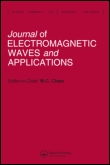
JOURNAL OF ELECTROMAGNETIC WAVES AND APPLICATIONS
Scope & Guideline
Illuminating the Spectrum of Electromagnetic Research
Introduction
Aims and Scopes
- Electromagnetic Wave Propagation and Scattering:
Research on the behavior of electromagnetic waves as they propagate through different media, including studies on scattering phenomena and the development of analytical and numerical methods for modeling these interactions. - Antenna Design and Optimization:
Innovative designs and optimizations of antennas for various applications, including MIMO systems, broadband, and multiband antennas, focusing on performance enhancement, miniaturization, and integration with modern communication systems. - Metamaterials and Metasurfaces:
Exploration of metamaterials and metasurfaces for applications such as absorption, cloaking, and polarization conversion, emphasizing their unique electromagnetic properties and potential uses in advanced technologies. - Microwave and Terahertz Technologies:
Advancements in microwave and terahertz technologies, including the design of filters, sensors, and other components, with a focus on high-performance applications in communications and imaging. - Computational Electromagnetics:
Development of computational methods for solving complex electromagnetic problems, including finite element methods, method of moments, and machine learning techniques for enhanced modeling and analysis. - Wireless Communication Systems:
Research on wireless communication technologies, including the design and analysis of antennas and systems for 5G and beyond, focusing on aspects like beamforming, channel estimation, and network optimization.
Trending and Emerging
- Machine Learning and AI in Electromagnetics:
An increasing number of papers are incorporating machine learning and artificial intelligence techniques to solve complex electromagnetic problems, optimize designs, and enhance signal processing capabilities. - 5G and Beyond Communication Technologies:
Research focused on the design and optimization of antennas and systems for 5G communications and future wireless technologies is rapidly growing, reflecting the industry's demand for advanced communication solutions. - Integrated and Flexible Electronics:
There is a notable trend towards the development of flexible and printed electronics, including antennas and sensors, that can be integrated into various substrates for wearable and IoT applications. - Advanced Metasurfaces:
The exploration of advanced metasurfaces for applications such as beam steering, polarization control, and electromagnetic absorption has gained significant traction, showcasing their potential in innovative designs. - Biomedical Applications of Electromagnetics:
Research focusing on the application of electromagnetic waves in biomedical fields, such as implantable devices and medical imaging, is emerging as a significant area of interest.
Declining or Waning
- Traditional Electromagnetic Theory:
Research directly focusing on classical electromagnetic theory, while still relevant, has seen a decrease in dedicated papers as more attention is being directed towards applied and innovative technologies. - Low-Frequency Applications:
Research related to low-frequency electromagnetic applications appears to be declining, possibly due to a growing emphasis on high-frequency technologies such as microwave and terahertz systems. - Basic Material Characterization:
The publication of studies focused solely on the characterization of materials without a clear application or innovative methodology has decreased, as the journal emphasizes more applied research. - Static Electromagnetic Fields:
Research on static fields and their applications has waned, as the field increasingly prioritizes dynamic and time-varying electromagnetic phenomena that are more relevant to current technological advancements.
Similar Journals

Visnyk NTUU KPI Seriia-Radiotekhnika Radioaparatobuduvannia
Innovating the Future of Radio EngineeringVisnyk NTUU KPI Seriia-Radiotekhnika Radioaparatobuduvannia is a distinguished open-access journal published by the National Technical University of Ukraine, Kyiv Polytechnic Institute. Since its inception in 2009, the journal has been a vital platform for disseminating innovative research findings in the fields of radio engineering, electronic technology, and the development of radio apparatus. With its commitment to providing unrestricted access to high-quality scientific content, the journal aims to foster collaboration and knowledge exchange among researchers, practitioners, and educators both in Ukraine and globally. While the journal's H-index and Scopus rankings are currently not provided, its growing reputation in the academic community is indicative of its impact in advancing technology and engineering practices. The journal's accessibility ensures that cutting-edge research is available to a wide audience, making it a crucial resource for professionals and students seeking to stay informed about the latest advancements in radio technology and engineering.

Journal of Electromagnetic Engineering and Science
Driving Innovation Through Open Access ResearchThe Journal of Electromagnetic Engineering and Science (ISSN: 2671-7255, E-ISSN: 2671-7263) is a premier Open Access journal published by the Korean Institute of Electromagnetic Engineering & Science. Since its establishment in 2001, it has been dedicated to advancing knowledge in the fields of Electrical Engineering, Electromagnetic Theory, and Communications, making significant contributions to both academia and industry. The journal holds an impressive Q2 quartile ranking in notable categories such as Computer Networks and Communications and Electrical and Electronic Engineering as of 2023, reflecting its robust scientific impact and reputation. It is indexed in Scopus, with commendable rankings in multiple fields, enhancing its visibility and reach among researchers. The journal's open-access model ensures that cutting-edge research is accessible to a global audience, fostering collaboration and innovation. Researchers, professionals, and students in the domain are encouraged to contribute and engage with high-quality articles that cover the latest advancements and trends in electromagnetic engineering and associated sciences.
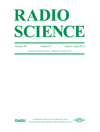
RADIO SCIENCE
Elevating Knowledge in Electrical Engineering and PhysicsRADIO SCIENCE, published by the American Geophysical Union, is a premier journal dedicated to advancing the field of electromagnetic research across various domains, including Earth and planetary sciences, electrical engineering, and condensed matter physics. With an impressive convergence of scholarly contributions from 1966 to 2024, the journal is recognized for its impactful research, reflected in its Scopus rankings and its Q2 quartile status across multiple relevant categories. It ranks 71st in general Earth and planetary sciences and 396th in electrical and electronic engineering, highlighting its broad reach and significance. Although not an Open Access journal, RADIO SCIENCE continues to engage a dedicated readership of researchers, professionals, and students eager to contribute to and benefit from cutting-edge discoveries in the electromagnetic sciences. The journal serves as a vital resource for fostering dialogue and collaboration among academics and practitioners alike, promoting excellence in research and innovation.
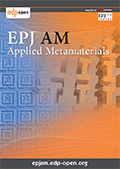
EPJ Applied Metamaterials
Exploring the Boundaries of Metamaterials InnovationEPJ Applied Metamaterials, published by EDP SCIENCES S A, is a leading open-access journal dedicated to the dynamic field of metamaterials and their applications in various domains of physics and engineering. Since its inception in 2014, this journal has provided a vital platform for researchers to share innovative findings and advancements, facilitating the widespread dissemination of knowledge in Condensed Matter Physics, Materials Science, and Mechanics of Materials. With an impressive trajectory towards becoming a significant resource for academia and industry alike, EPJ Applied Metamaterials has achieved a commendable Q3 ranking in relevant categories according to the 2023 metrics, indicating its increasing impact within the scientific community. The journal is committed to fostering open dialogue and collaboration through its open-access model, ensuring that all research is freely accessible to a global audience. Scholars, professionals, and students alike are invited to contribute to this evolving field, harnessing the journal as a means to influence both theoretical and applied metamaterial research.

IEEE Letters on Electromagnetic Compatibility Practice and Applications
Empowering Collaboration in EMC Research and Practice.IEEE Letters on Electromagnetic Compatibility Practice and Applications is a reputable journal published by the IEEE-Institute of Electrical and Electronics Engineers Inc., focusing on the critical and dynamic field of electromagnetic compatibility (EMC). This journal provides a vital platform for researchers, professionals, and students to disseminate their findings on the practical applications and theoretical advancements related to EMC. With the increasing reliance on electronic systems in various industries, the significance of mastering electromagnetic compatibility cannot be overstated. Although there is no official impact factor listed yet, the journal is committed to maintaining a high standard of scholarly excellence. With its open access model, it ensures that groundbreaking research is freely available to the global community, promoting collaboration and innovation in the field. The journal's focus on real-world applications makes it a crucial resource for those looking to stay at the forefront of electromagnetic research and practice.
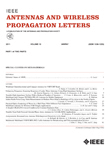
IEEE Antennas and Wireless Propagation Letters
Illuminating Pathways in the World of Wireless EngineeringIEEE Antennas and Wireless Propagation Letters serves as a premier platform for disseminating cutting-edge research in the realm of antennas and wireless propagation, published by the esteemed IEEE-INST ELECTRICAL ELECTRONICS ENGINEERS INC. With a notable impact factor and recognized as a Q1 journal in the category of Electrical and Electronic Engineering, it holds a prestigious position within the academic community, ranking 135th among 797 journals in its field, placing it in the 83rd percentile. This journal, which has been continuously published since 2002, showcases a wealth of innovative studies and advancements aimed at enhancing the efficiency and effectiveness of wireless communication technologies. Although it does not offer open access options, its contributions are invaluable for researchers, engineers, and students seeking to stay at the forefront of technological progress in wireless systems. The journal encourages submissions that address fundamental and applied aspects of antenna technology and propagation phenomena, ensuring that the content remains relevant and insightful for the rapidly evolving landscape of electronic engineering.

Advances in Radio Science
Connecting Innovators in Radio ScienceAdvances in Radio Science, published by COPERNICUS GESELLSCHAFT MBH, is a leading open-access journal established in 2003, dedicated to the rapid dissemination of high-quality research in the field of radio science, particularly focusing on advancements in electrical and electronic engineering. With an ISSN of 1684-9965 and an E-ISSN of 1684-9973, this journal is indexed and provides an avenue for researchers to contribute to the latest developments and innovations within the domain. Despite its current Q4 ranking in the Electrical and Electronic Engineering category, its commitment to open access ensures that all published articles are freely available to a global audience, fostering collaboration and knowledge sharing among engineers, researchers, and students alike. Situated in Göttingen, Germany, the journal continues to evolve and expand its reach, with content converging until 2024, emphasizing its relevance in a rapidly changing technological landscape. Whether you're a seasoned researcher or an emerging scholar, Advances in Radio Science invites you to explore the frontiers of radio science and contribute to its growing body of knowledge.
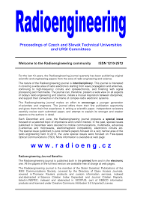
Radioengineering
Connecting scholars to cutting-edge research in radioengineering.Radioengineering is a prominent academic journal published by SPOLECNOST PRO RADIOELEKTRONICKE INZENYRSTVI, focusing on the fields of electrical and electronic engineering. Established in 1992, this open access journal aims to disseminate high-quality research and innovative developments in radioengineering and related disciplines. With an inclusive readership from around the world, it has been integral in fostering advancements in technologies such as wireless communication, signal processing, and electromagnetic theory. The journal's commitment to accessibility is underscored by its open access policy, allowing scholars and practitioners to freely engage with the latest findings. As of 2023, *Radioengineering* holds a Q3 quartile ranking in its field with a Scopus rank of #500/797, placing it within the 37th percentile among its peers. Researchers, professionals, and students engaged in electrical and electronic engineering will find *Radioengineering* an essential resource for both theoretical insights and practical applications. For further information, submissions, and access to articles, please visit the journal’s site linked through the CZECH TECHNICAL UNIVERSITY, located in Prague, Czech Republic.
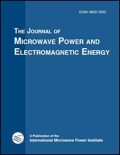
JOURNAL OF MICROWAVE POWER AND ELECTROMAGNETIC ENERGY
Catalyzing Collaboration in Cutting-edge Electromagnetic ResearchThe Journal of Microwave Power and Electromagnetic Energy, published by Taylor & Francis Inc, is a premier scholarly journal dedicated to the advancement of research in the fields of microwave power and electromagnetic energy. With a strong focus on innovative applications and theoretical developments, this journal serves as a vital platform for researchers, professionals, and students alike, fostering collaboration and dissemination of cutting-edge findings since its inception in 1985. Although currently categorized in the Q3 and Q4 quartiles across various disciplines such as Ceramics and Composites, Electrical and Electronic Engineering, and Condensed Matter Physics, the journal consistently emphasizes both experimental and computational methodologies. As part of its commitment to excellence, the journal is indexed in Scopus, boasting a rank of #76 in Metals and Alloys and a percentile standing that reflects its niche yet significant role in the scientific community. While the journal does not offer Open Access options, it remains an essential resource for those invested in the evolving landscape of microwave technology and electromagnetic energy research, with converged years extending through 2024. Researchers are encouraged to contribute impactful articles that can inspire breakthroughs and fuel further inquiries in this dynamic field.

Journal of Infrared Millimeter and Terahertz Waves
Driving Interdisciplinary Collaboration in Wave ResearchJournal of Infrared Millimeter and Terahertz Waves, published by Springer, is a pivotal academic outlet in the realms of condensed matter physics, electrical and electronic engineering, instrumentation, and radiation, with an impressive impact factor underscoring its relevance in contemporary research. This journal, with both ISSN 1866-6892 and E-ISSN 1866-6906, offers open access to its articles, ensuring that the latest findings are widely disseminated and accessible to the global scientific community. Ranked in the Q2 quartile across multiple categories, including a notable 9th percentile ranking in radiation within the Scopus database, this journal serves as a significant platform for researchers and professionals. With a publication history spanning from 2008 to 2024, it continues to enrich the field with high-quality research articles, reviews, and insights. The journal's commitment to fostering innovation and interdisciplinary collaboration makes it an essential resource for anyone involved in the investigation and application of infrared, millimeter, and terahertz technologies.